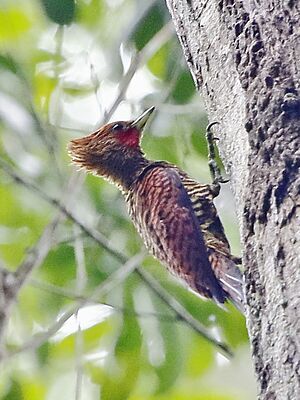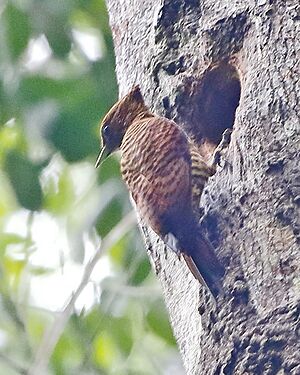Waved woodpecker facts for kids
Quick facts for kids Waved woodpecker |
|
|---|---|
 |
|
| Male | |
 |
|
| Female at nest | |
| Conservation status | |
| Scientific classification | |
| Genus: |
Celeus
|
| Species: |
undatus
|
| Subspecies | |
|
See text |
|
| Synonyms | |
|
|
The waved woodpecker (Celeus undatus) is a type of bird that belongs to the woodpecker family. These interesting birds live in South America. You can find them in countries like Bolivia, Brazil, Colombia, Ecuador, French Guiana, Guyana, Peru, Suriname, and Venezuela.
Contents
About the Waved Woodpecker's Name
Scientists give every living thing a special two-part name. This helps everyone around the world know exactly which animal they are talking about. The waved woodpecker's scientific name is Celeus undatus.
A long time ago, in 1764, a naturalist named George Edwards first drew and described this woodpecker. He called it the "Red-cheeked Wood-pecker". Later, in 1766, a famous Swedish scientist named Carl Linnaeus gave it the scientific name Picus undatus. He got the name undatus from a Latin word meaning "wavy" or "wavelike". This name likely refers to the wavy patterns on the bird's feathers.
Today, scientists place this woodpecker in a group called Celeus. This group was created by a German zoologist named Friedrich Boie in 1831.
Different Types of Waved Woodpeckers
Scientists sometimes disagree on how to group animals. For a long time, the waved woodpecker was thought to have three main types, called subspecies. But in recent years, new studies have suggested that four other types of woodpeckers, once called "scaly-breasted woodpeckers," are actually part of the waved woodpecker family.
Now, many bird experts, like those at BirdLife International and the International Ornithological Committee (IOC), recognize seven subspecies of the waved woodpecker. However, some other groups, like the American Ornithological Society (SACC), still consider the scaly-breasted woodpecker a separate species.
The seven subspecies recognized by some experts are:
- C. u. amacurensis
- C. u. undatus
- C. u. multifasciatus
- C. u. verreauxii
- C. u. grammicus
- C. u. subcervinus
- C. u. latifasciatus
What Does the Waved Woodpecker Look Like?
The waved woodpecker is a medium-sized bird. It is about 23 to 26 centimeters (9 to 10 inches) long. Males usually weigh a bit more than females.
Colors and Patterns
The most common type, C. u. undatus, has a light, reddish-brown head with a fluffy crest. This crest can sometimes have black stripes. The sides of its neck also have black streaks.
- Males have a bright red stripe that goes from behind their beak to their ears.
- Females do not have this red stripe.
Both male and female adults have a light, creamy chin and throat. These areas have black spots or bars. Their upper bodies are reddish-brown with wide black stripes. The lower back is often lighter and more yellow. Their flight feathers are black with reddish-brown stripes. Their tail is black with reddish stripes on top.
The underside of their body is reddish, with the belly being lighter than the chest. The chest has wavy black stripes, and the belly has more regular stripes. Females usually have more noticeable stripes than males.
Other Features
The waved woodpecker has a short beak that is dull yellow to yellow-green. Its eyes are red-brown to red, and its legs are green-gray. Young woodpeckers look a lot like adults but are generally duller in color.
Differences in Subspecies
Different subspecies can look a little different:
- C. u. amacurensis is darker and more reddish-brown than the common type. Its head is the same color as its body.
- C. u. multifasciatus is the largest subspecies. It is paler and more yellowish. It often has a tail without stripes.
- The C. u. grammicus subspecies (the former scaly-breasted woodpecker) has a reddish-brown head with a pointed crest. Males also have a red patch on their face. Their upper bodies have narrow black stripes.
Where Do Waved Woodpeckers Live?
Waved woodpeckers live in different parts of South America. Each subspecies has its own specific area:
- C. u. amacurensis lives in northeastern Venezuela.
- C. u. undatus is found in eastern Venezuela, the Guianas, and northeastern Brazil.
- C. u. multifasciatus lives in northeastern Brazil.
- C. u. verreauxii is found in south-central Colombia and eastern Ecuador.
- C. u. grammicus lives from southeastern Colombia and southern Venezuela down to Peru and western Brazil.
- C. u. subcervinus is found in Brazil.
- C. u. latifasciatus lives in southeastern Peru, southwestern Brazil, and northern Bolivia.
These woodpeckers prefer to live in different types of forests. This includes the inside and edges of rainforests, both dry and flooded forests, and even areas with scattered trees. They usually live at elevations between 100 and 900 meters (330 to 2,950 feet) above sea level.
Waved Woodpecker Behavior
Waved woodpeckers stay in the same area all year round. They do not migrate.
What Do They Eat?
Waved woodpeckers mainly eat ants and termites. They also enjoy tree sap, seeds, fruits, and berries. They usually look for food alone, in pairs, or in small family groups. Sometimes, they join groups of different bird species that are foraging together. They search for food on tree trunks, branches, and vines, from the middle of the forest to the very top. They find their food by pecking, poking, and picking it off surfaces.
Reproduction and Nests
Waved woodpeckers build their nests by digging a hole in a living or dead tree. They usually make their nests high up, between 4 and 30 meters (13 to 98 feet) above the ground. We don't know much about how many eggs they lay or how long it takes for the eggs to hatch.
Sounds and Calls
The waved woodpecker has a high, nasal song that sounds like "fuweét-eeuh." It also makes a soft, quiet sound like "kowahair." Both male and female woodpeckers also make drumming sounds by pecking on trees.
The "scaly-breasted" woodpecker, which some consider a subspecies, has different calls. Some of its common sounds are "curry-kuuu" and "pring-pring!" notes. These "pring-pring!" sounds are very loud and metallic.
How Are Waved Woodpeckers Doing?
The IUCN (International Union for Conservation of Nature) has listed the waved woodpecker as a species of "Least Concern." This means that, for now, they are not considered to be in danger of disappearing.
However, even though they live across a very large area, we don't know exactly how many waved woodpeckers there are. Scientists believe their numbers might be going down. This is mainly because their forest homes are being cut down for farming and ranching.
The original waved woodpecker (with three subspecies) is not very common and not much is known about it. But it does live in some protected areas. The "scaly-breasted woodpecker" (now considered a subspecies by some) is more common in different parts of its range. It also lives in several protected areas, which helps keep them safe.


